The pressure systems are now re-arranging over the Northern Hemisphere, creating a unique winter weather pattern for the rest of the month and for the early days of 2022. As the polar vortex battles with a warming in the stratosphere, a strong wave disturbance emerges in the tropics, that will set up a unique blocked pattern over the Northern Hemisphere.
We were talking about these upcoming pressure changes in our previous articles. There are some very strong weather drivers behind these changes, that command the weather patterns each winter season. We always tend to explain the behind-the-scenes processes at work, so you can much easily understand the grand scale of weather development.
First, we will look at the most important weather drivers in a very simplified manner, which will reveal how they work each in their unique way to create our everyday weather. This way, you will be able to quickly learn some of the “behind the scenes” of winter weather patterns in the Northern hemisphere.
Next, we will look directly at the weather forecast for the rest of December 2021, the developing Christmas trends, and the weather trends for the early days of 2022. Below we have an example image of a very “textbook” intense winter pattern, featuring a strong blocking high-pressure system in the North Atlantic.
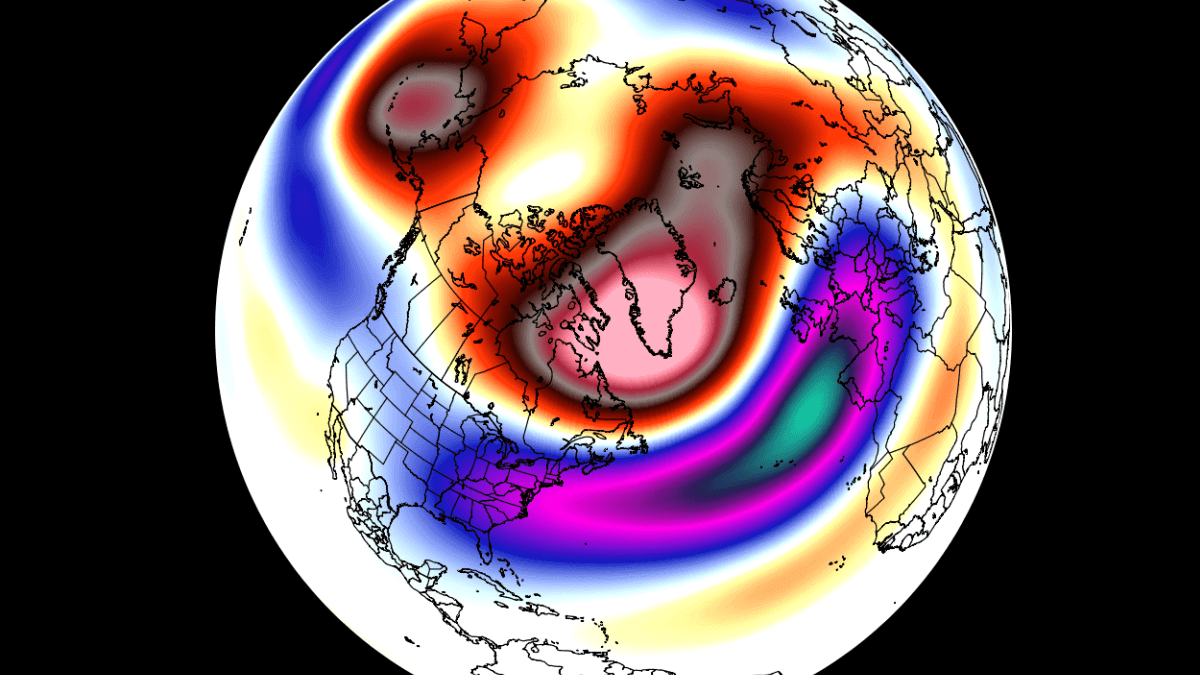
WINTER WEATHER GLOBAL DRIVERS
The meteorological winter season starts on December 1st, and lasts for 3 months, covering December, January, and February. When we look at the seasonal forecasts for winter, we always look at the large-scale climate drivers first, as they have a very long period of change and are quite stable. That has obviously been the La Nina in the tropical Pacific Ocean.
But once we get into the actual winter season, we have to look at the short-term variability. Besides the La Nina which we will also cover briefly below, we have two other drivers of the global weather. They are the now-famous Polar Vortex and the less known (but powerful) Madden-Julian Oscillation, known mostly as MJO.
Together, all three form the “triple crown” of winter weather, changing our weather on different scales by size and time, working in their own right. We will first look at the shorter-term Polar Vortex and the MJO development and quickly look at the background large-scale La Nina influence.
NORTH HEMISPHERE POLAR VORTEX
Every year as we head into autumn, the polar regions start to receive much less sunlight and sun energy. This means that the north pole starts to cool down. But as the polar regions are cooling, the atmosphere further south is still relatively warm as it continues to receive energy from the Sun. You can see the winter solstice on the image below when the polar regions receive little to zero solar energy, compared to regions further to the south.
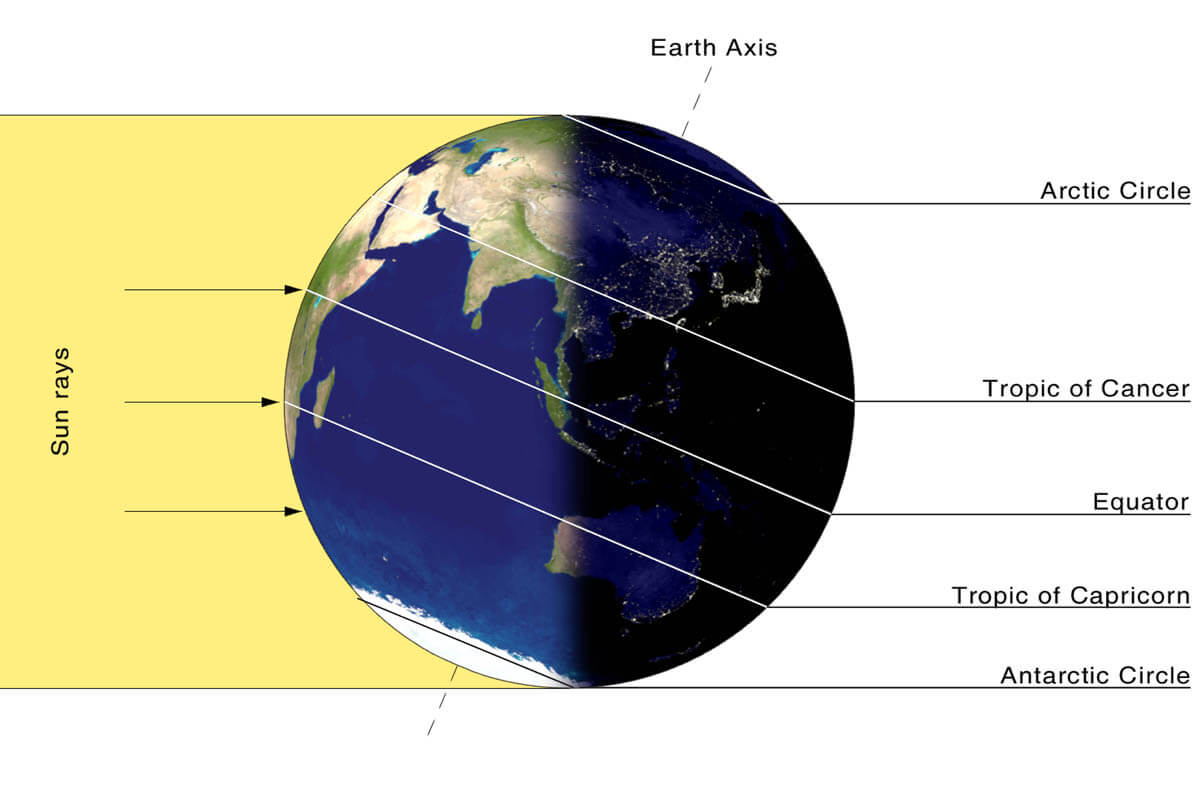
But, as the temperature begins to drop over the polar regions, so does the pressure. With colder temperatures over the pole, the temperature difference towards the south increases. This also causes a pressure difference as a large low-pressure (cyclonic) circulation starts to develop across the Northern Hemisphere from the surface layers, far up into the stratosphere. This is known as the Polar Vortex.
While the stratospheric polar vortex is spinning high above our weather, it is still directly connected to the lower part and can shape our daily weather in one way or another, as one large hemispheric circulation.
The image below shows a typical example of the Polar Vortex at around 30km/18.5miles altitude (10mb level) around the middle stratosphere during the winter season.
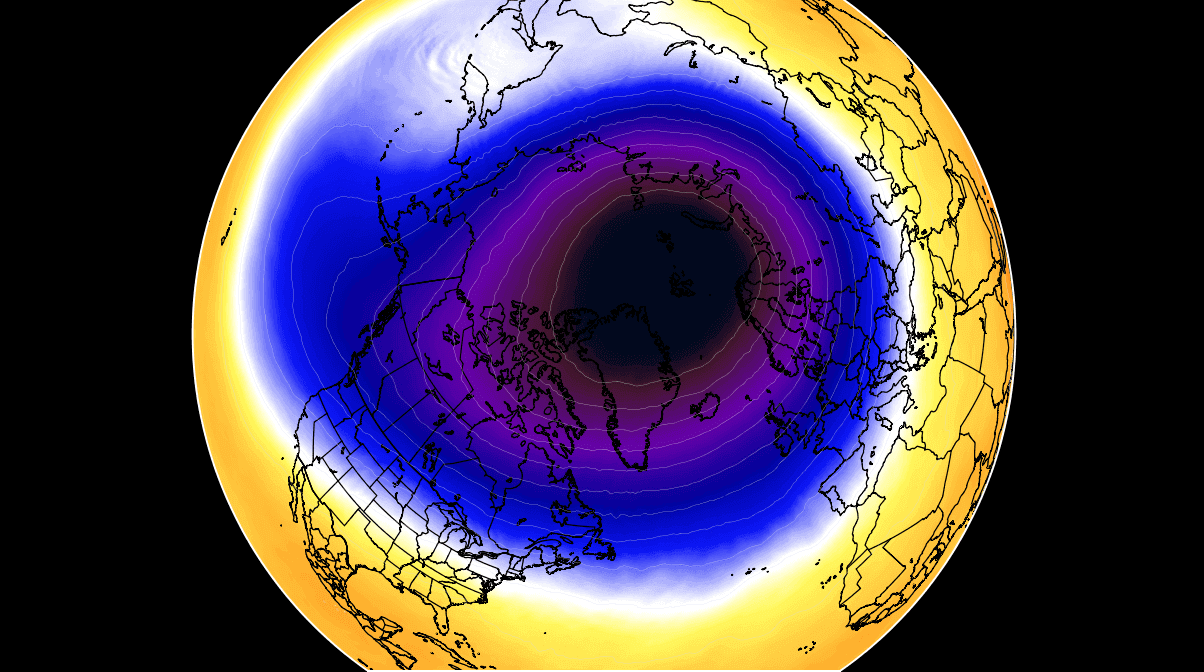
It is basically like a very large cyclone, covering the whole north pole, down to the mid-latitudes. It is strongly present at all levels, from the ground up, but can have quite a different shape at different altitudes.
The next image below will show you the polar vortex at a much lower altitude, around 5km/3miles. It reveals the true shape and size of the polar vortex closer to the ground (cold colors). The closer to the surface we get, the more deformed the polar vortex becomes. That is because of the increased terrain/ground influence and the dynamics from many weather fronts and systems.
Be aware of “arms” extending from the polar vortex into the lower latitudes, bringing along colder air and snowfall. These arms also pack a lot of energy and can create strong winter storms, either Noreasters in the United States or powerful wind storms in the North Atlantic.
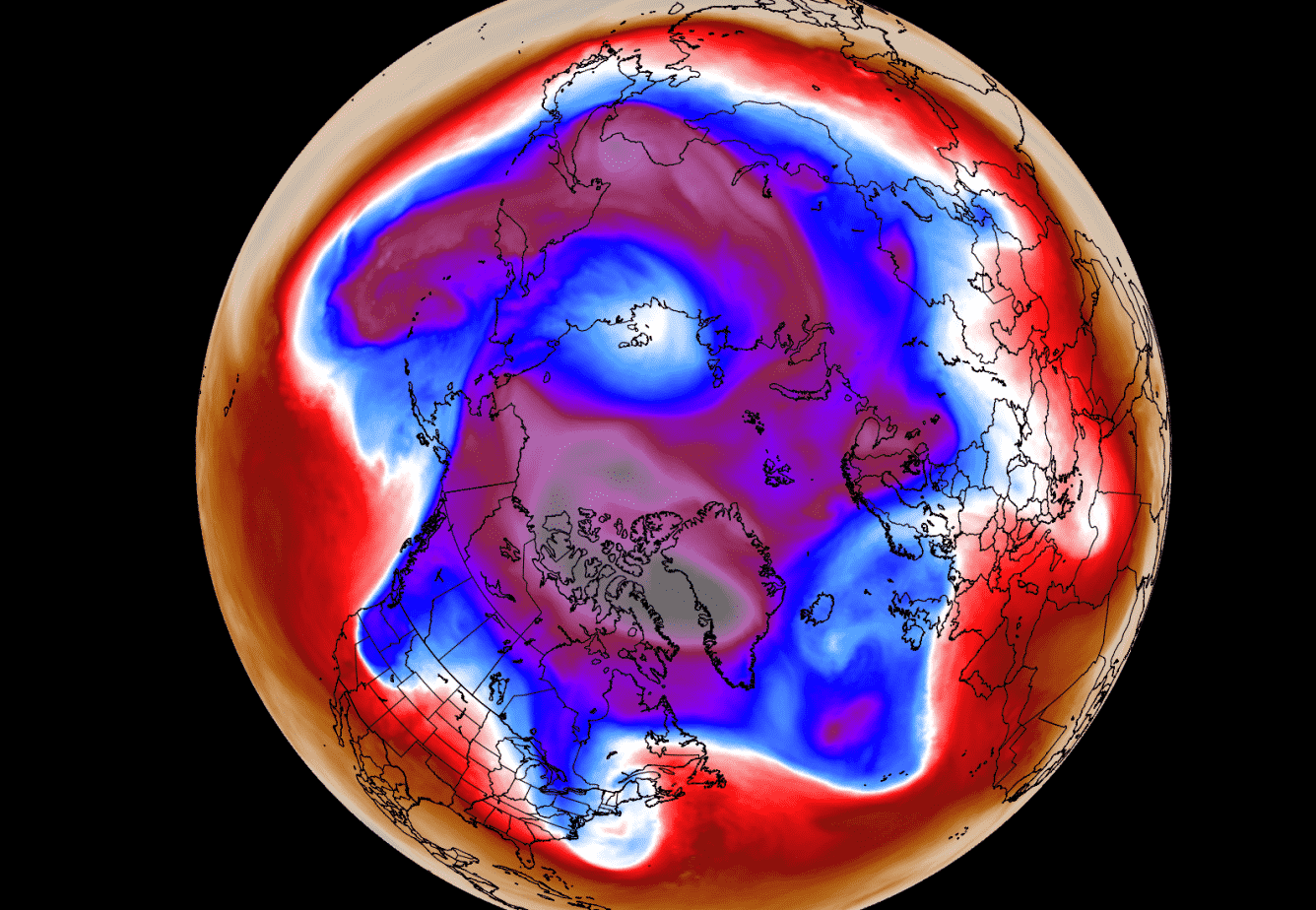
We are currently focusing mostly on the Stratospheric Polar Vortex, as it plays a very important role in the weather development throughout the season. It is known for its strong influence down from the stratosphere, in either direction, for a cold or warm winter.
A strong polar vortex usually means stronger polar circulation even in the lower levels of the atmosphere. This can usually lock the cold air into the Polar regions, creating milder winter for most of the United States and Europe. On the other hand, a Polar Vortex breakdown is just as powerful as it sounds, as the higher pressure pushes down from the stratosphere into the Polar Circle. That can push the colder air out of the polar regions, into the United States and/or Europe. Image by NOAA.

Typically, a polar vortex circulation collapses due to a rise in temperature in pressure in the stratosphere. That is called a Sudden Stratospheric Warming (SSW) event. And as the name suggests, it is a sudden rise in temperatures in the stratosphere.
But there can also be smaller warming waves in the stratosphere, that do not collapse the polar vortex. Instead, they can sometimes displace or disrupt the polar vortex enough to weaken its influence on the surface levels. That can allow other drivers to take over more strongly, creating a different weather pattern.
We produced a video below, covering December 2020 to January 2021 period, from NASA GEOS-5 data. Video shows the vorticity parameter, which (simplified) means that it shows the energy of the polar vortex. Notice how the polar vortex covers a large part of the Northern Hemisphere. You can see a strong stratospheric “anti-vortex” over the North Pacific, attacking the Polar Vortex, as it spins in the opposite (clockwise) direction.
The main takeaway from the video should be that the Polar Vortex is not just one single winter storm that moves from the Midwest into the northeastern United States. It is one large cyclonic area that is spinning over the entire Northern Hemisphere, from the ground up to the top of the stratosphere and beyond, reaching over 50km/31miles in altitude.
The warming is now already starting, reaching the first peak around or after Christmas. Below we have a temperature forecast for the middle stratosphere around that time. It shows the cold-core of the polar vortex and the warming wave over Siberia and east Asia.
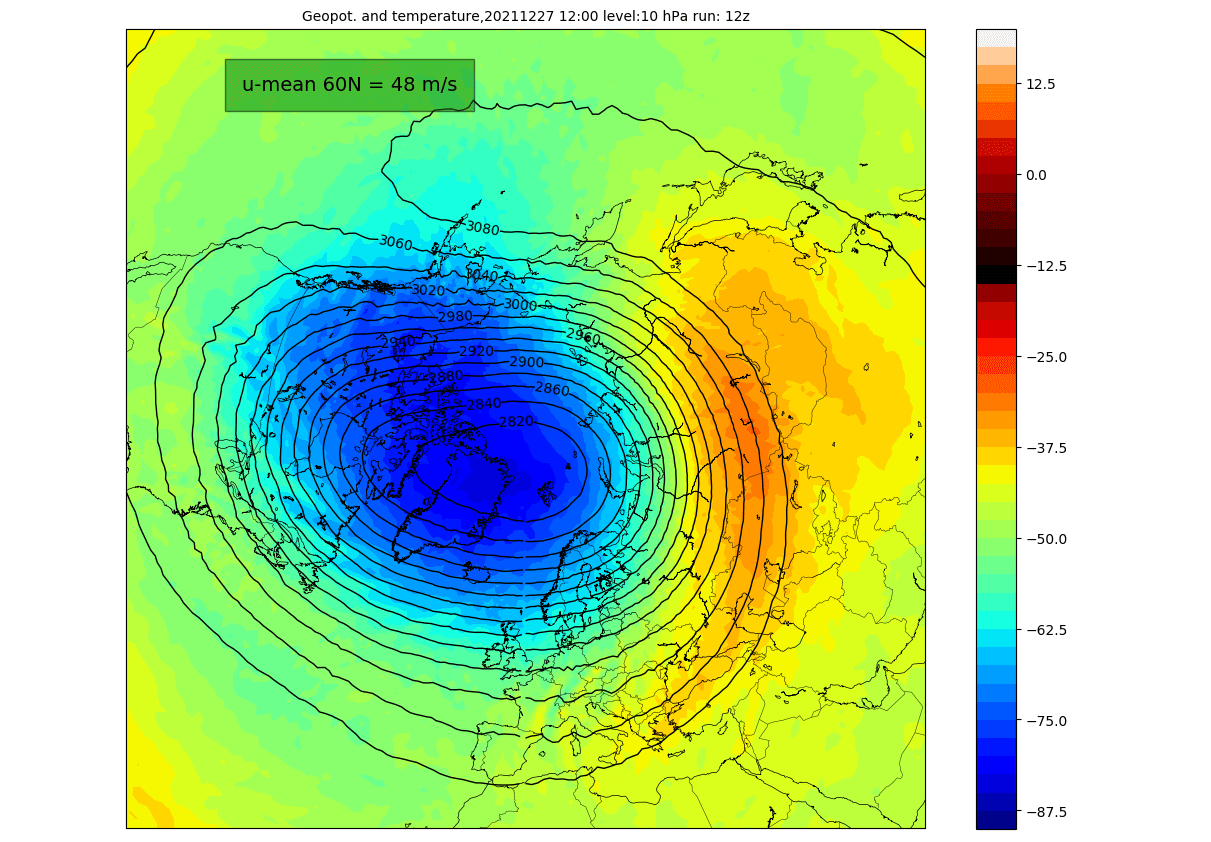
But why is this important? Well, every disruption in either a warming or a pressure wave in the stratosphere can mean a change in dynamics. In this case, it can try to limit the influence from an otherwise strong polar vortex in the stratosphere.
As far as the stratosphere and weather connection goes, there is a special graphic that puts that into a simple perspective. We can look at the pressure development from the surface up into the stratosphere over time.
The next image shows that nicely, revealing the strong polar vortex in the forecast, pushing down from the stratosphere. But the influence is not really reaching down to the surface directly, as strong high-pressure systems in the lower levels are strong enough to fight back.
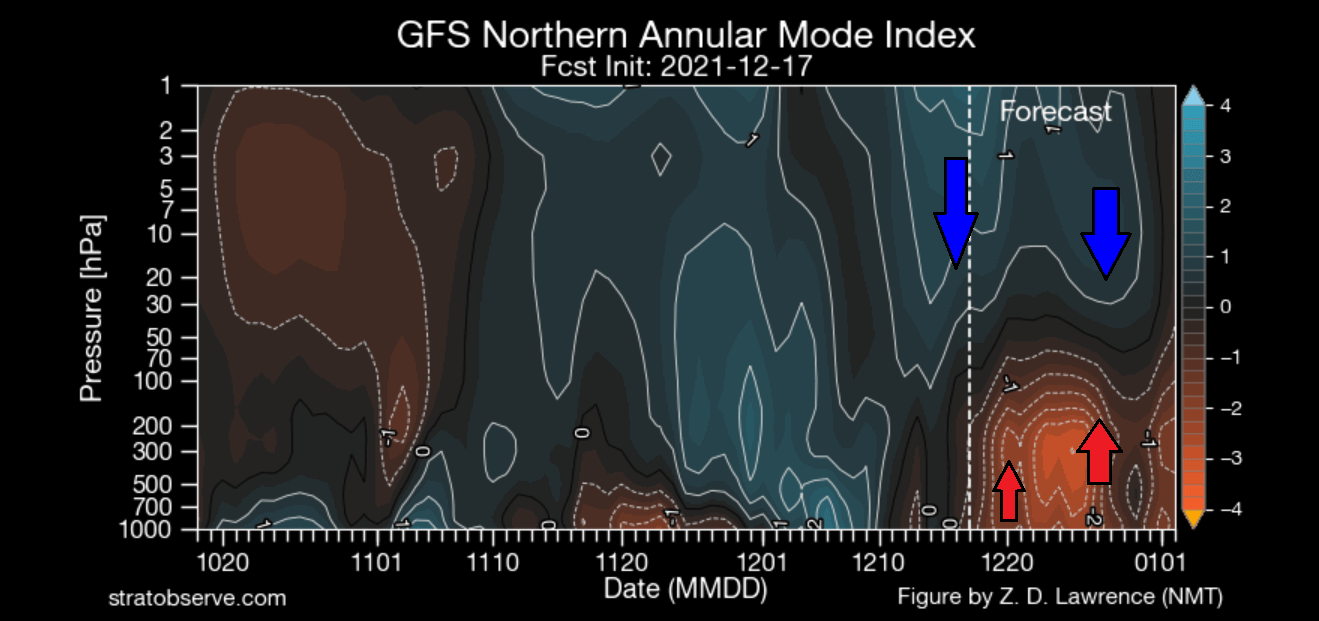
If there weren’t a warming wave with a potential displacement, the polar vortex dynamics might have played out differently. We could be seeing a stronger influence from the top down. So this is the first “crown” that falls into place for a more dynamic weather pattern over the Northern Hemisphere.
Basically, this allows the other factors to have more influence than they might otherwise have, “unlocking” their importance in the grand scheme of weather patterns across the Northern Hemisphere. So while the strong influence of the Polar Vortex is always very important, the lack thereof can be as well.
MJO WEATHER WAVE
Going from the stratosphere down into the tropics, we have quite different dynamics. A lot of the tropical variability is driven by invisible wave-like features in the atmosphere. The largest and most dominant source of short/medium-term tropical variability is the Madden-Julian Oscillation wave, known as MJO.
But what is this MJO wave? This is an eastward moving disturbance (wave) of thunderstorms, clouds, rain, winds, and pressure changes. It moves around the entire planet on the equator in about 30 to 60 days.
It has the power to influence the weather patterns further north over the North Hemisphere, as there is a strong connection between the tropical pressure changes and the global weather.
The MJO consists of two parts: one is the enhanced rainfall (wet) phase and the other is the suppressed rainfall (dry) phase. The graphic below from NOAA Climate shows the basic pattern of this wave. We have increased storms and rainfall (lower pressure) on one side and fewer storms and drier weather (higher pressure) on the other side. Image by NOAA Climate.
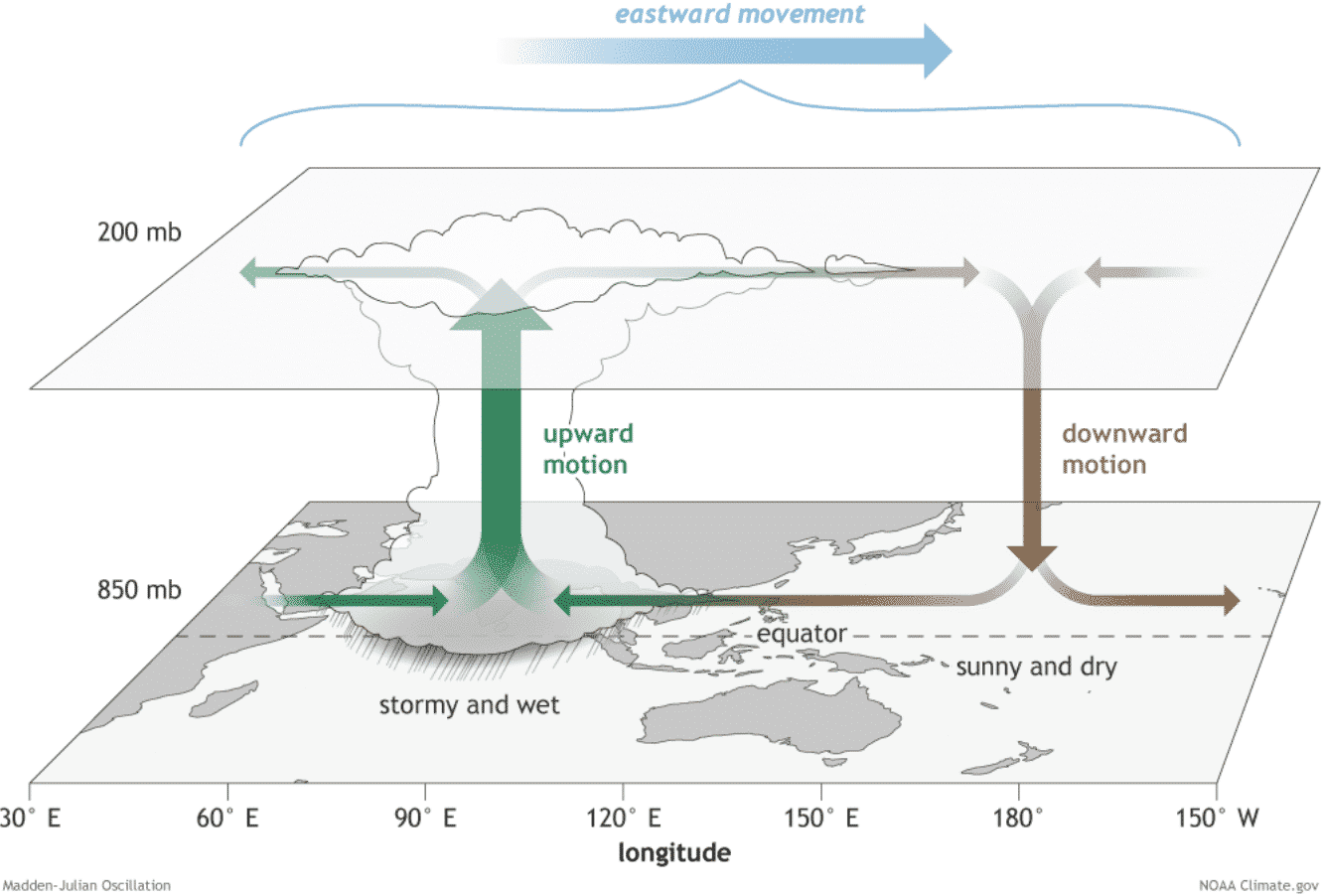
The image below shows exactly how this wave travels across the equator. Notice the precipitation anomalies in the tropics. Green and blue colors show more precipitation and storms, and brown colors show less precipitation and higher pressure. This way, we can observe how the MJO wave moves across the tropics.

It is important to note how this wave is consistent enough to be arranged into phases. Each has a slightly different influence on the global weather. That is why we need to keep track of how it is moving around the globe.
The pressure changes it brings along can affect one region of the world more directly, thus also hawing down/upstream effects on the rest of the global weather.
Looking at the current forecast below from ECMWF, it shows that Phase 7 will be active for most of the remainder of the month. We will look below how a typical phase 7 influence looks like on the temperature and pressure across the world.

Below we have a composite image of phase 7 in December, showing the average pressure pattern for this phase. We can see right away, that there are two main high-pressure systems. One is in the North Pacific and the Aleutians and one over Scandinavia and northwestern Europe.

This means lowered pressure over Canada and the northern United States, bringing the jet stream and colder temperatures also down to the northern United States. Over Europe, this enables lowered pressure over central and southern regions and opens the door to the cold from the east.
Speaking of temperatures, below we have the same composite image, but for temperatures. Perhaps it is a bit harder to interpret due to the contour lines. But we have colder temperatures over Canada and the northern parts of the United States. Over Europe, we can notice the transport of colder air from the east/northeast.

This is the weather pattern that we will be looking for in the main part of the article below, which contains the weather forecast for the rest of December and early January 2022. The forecast above for the MJO shows a strong signal for phase 7, so we should be seeing some of this reflected in the weather patterns.
We are now going from the atmosphere down into the Ocean. There we will find the true climate behemoth, the famous large-scale, long-term, climate influencer that is setting the main playing field for the winter season 2021/2022. It is the ENSO in the tropical Pacific Ocean, which we have talked about many times before.
ENSO AND ITS COLD LA NINA
Continuing in a simple way, ENSO is short for “El Niño Southern Oscillation”. This is a large region of the tropical Pacific ocean. It is always changing between a warm and cold phase, called El Nino and La Nina, respectfully.
ENSO has a major impact on the tropical convection patterns (storms) and the complex interaction between the ocean and the atmosphere. We can observe long-term pressure changes in the tropics as ENSO starts to shift between warm and cold phases. With some delay, these changes directly affect the circulation over the rest of the world.
The image below shows the ENSO regions in the tropical Pacific. Most analysis and forecasts are based on a combination of regions 3 and 4, seen on the image as the Nino 3.4 region. Region 3 covers the eastern tropical Pacific, while region 4 covers the central and western parts.
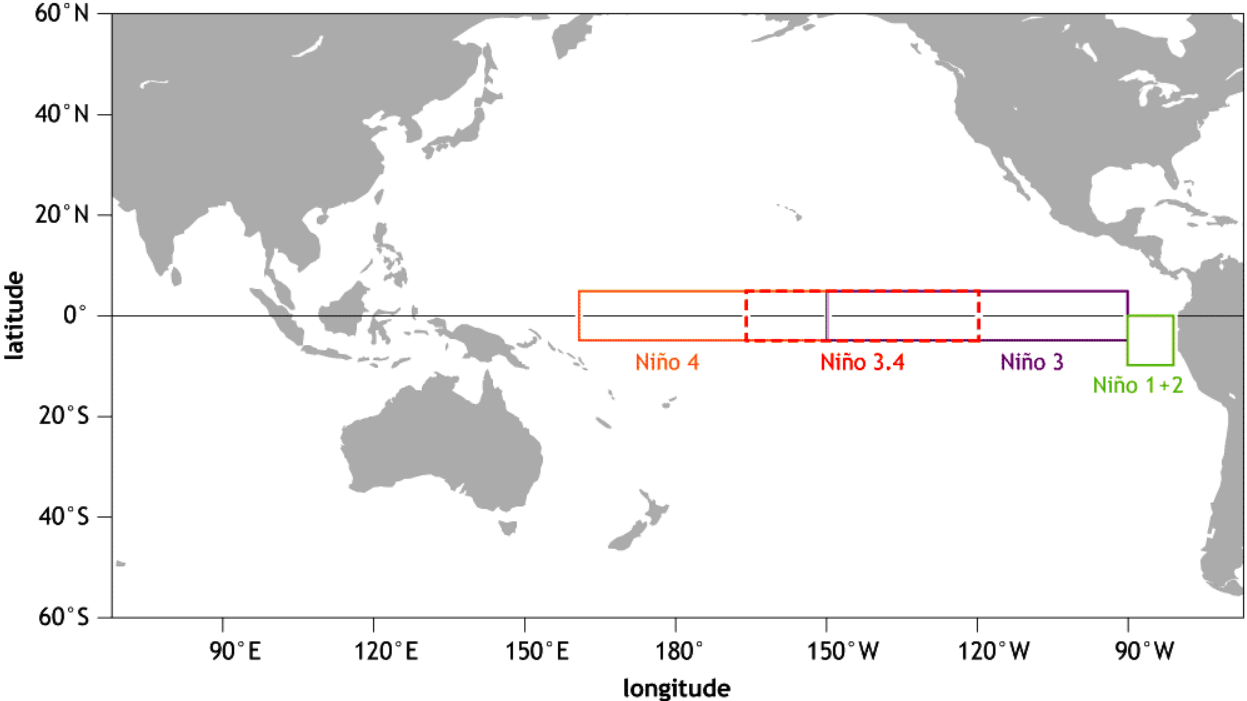
Each ENSO phase has a different effect on the pressure and weather in the tropics. This translates to the overall global circulation, impacting the weather worldwide differently. A specific phase (cold/warm) usually develops between late summer and fall and typically lasts till next summer. Some stronger events can last even up to two years.
The cold ENSO phase is called La Nina and the warm phase is called El Nino. Their names literally translate to “the girl” from the La Nina, while El Nino translates to “the boy”, indicating an opposite dynamic between the two phases.
But besides the temperatures, one of the main differences is also in the pressure state. During an El Nino, the pressure over the tropical Pacific is lower, with more rainfall and storms.
But during a La Nina, the pressure over the equatorial Pacific is high, creating stable conditions and less precipitation. This obviously translates into the global circulation, affecting the jet stream on both Hemispheres over time.
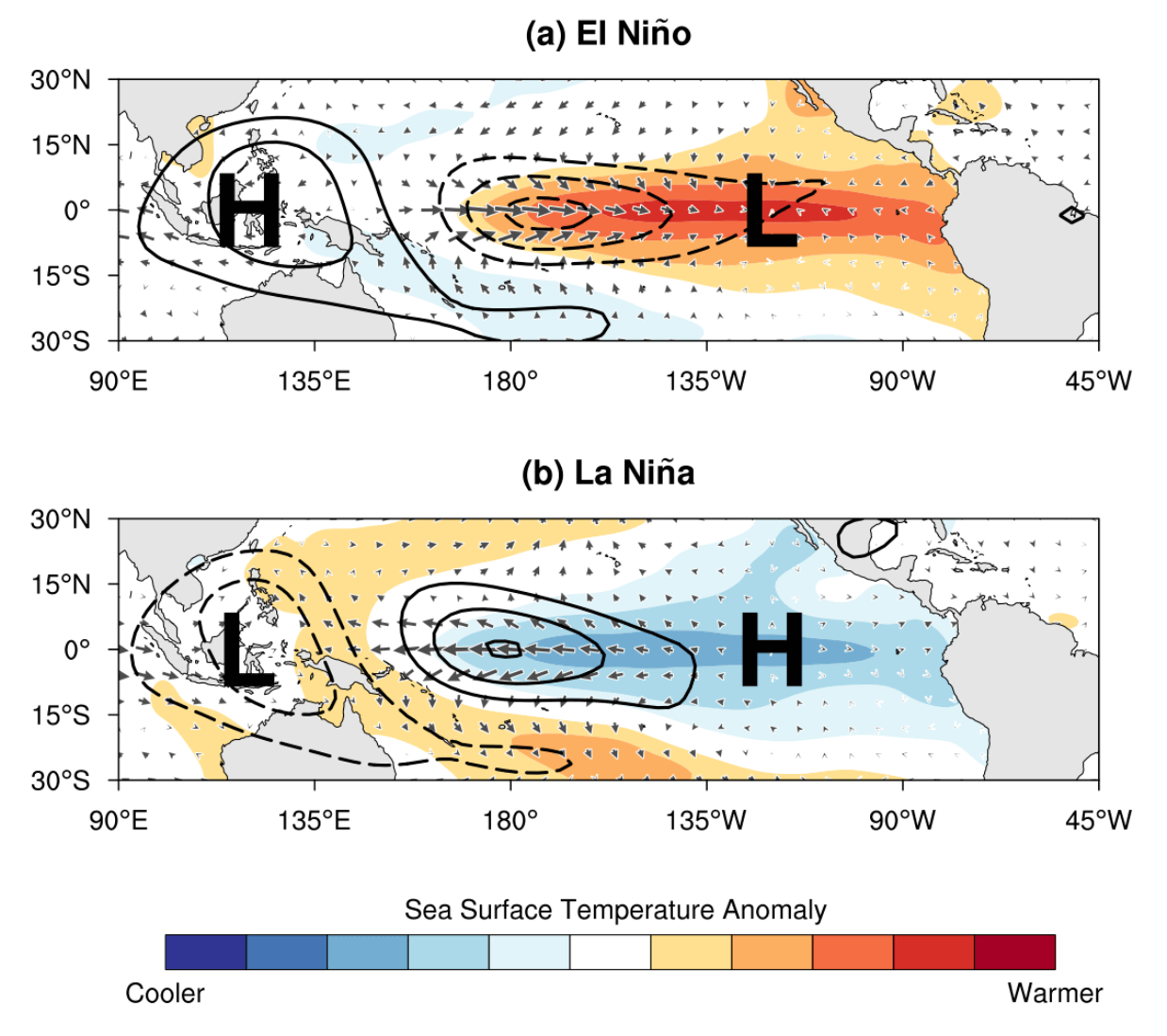
Below we have the global ocean temperature analysis from NOAA. We can clearly see the strong cold anomalies in the tropical Pacific Ocean. That is the currently active La Nina phase. The strongest cold anomalies can be found in the eastern region, going more than 3°C below the long-term average. Overall, the current event is marked as a moderately-strong La Nina.

The combined/consolidated forecast calls for the La Nina to last over the winter and into early Spring 2022. This is a typical scenario, going into a neutral state during the warmer part of the year. Typically a new phase tends to develop in late summer or early fall. We can see a warm phase (El Nino) being forecast for late 2022,
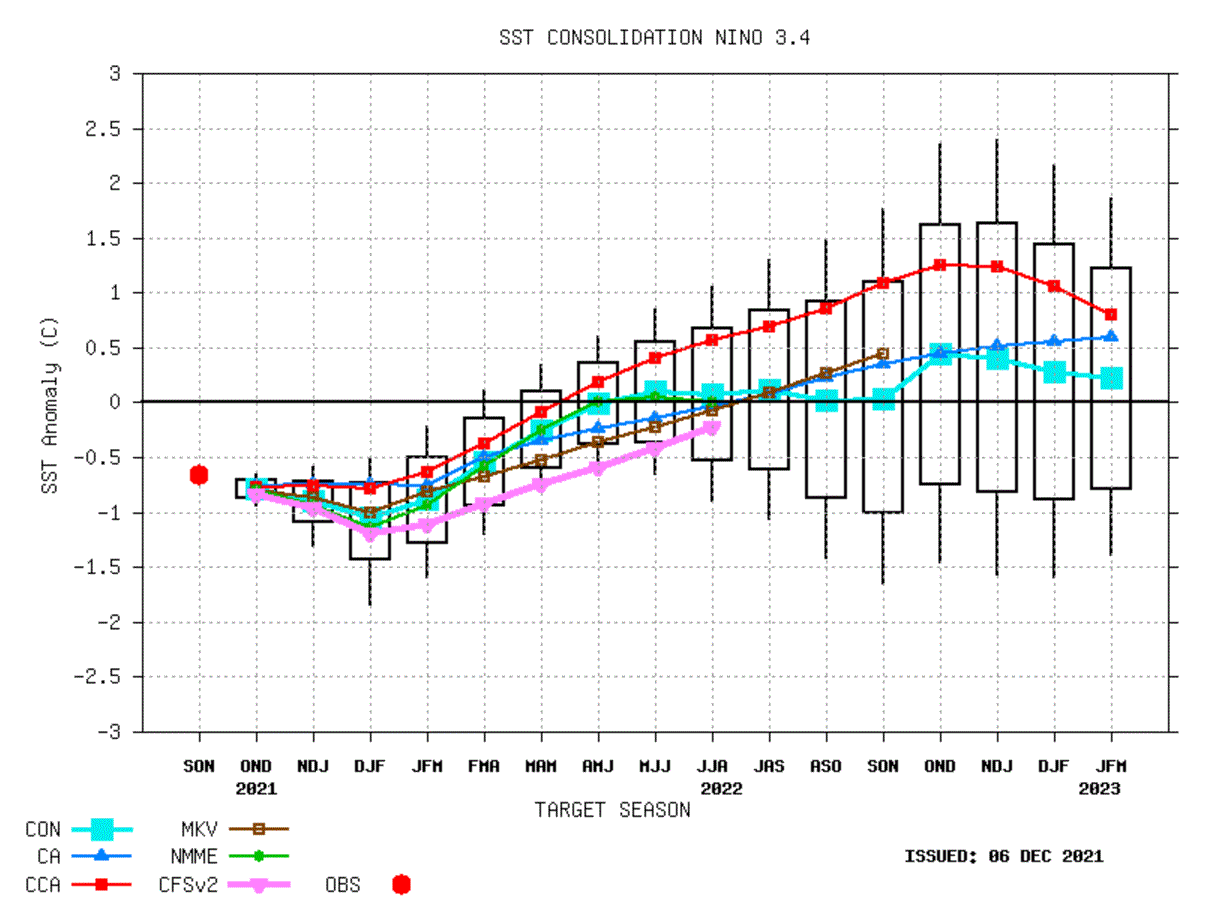
Below we have an image that shows the average winter pressure pattern from multiple La Nina winters. The main feature is of course the high-pressure system in the North Pacific and low pressure over Canada. That is the typical signature of the cold ENSO phase. Over Europe, we see lower pressure over Scandinavia and higher pressure over northwestern Europe, but that cannot be designated as a typical weather response from the La Nina.

If you remember the MJO from the previous segment, this was also the main signature of phase 7 we have now entered. A high-pressure system in the North Pacific and northern Europe and low pressure over Canada and the northern United States.
This means that the MJO and the La Nina are in this case can “boost” each other, as they both force towards the same pattern. They are at the end of the day both emerging in the tropics, but working at different time scales.
We will now be looking for this pattern in the forecast, to see how the combined influence of these winter weather drivers will really translate into our every day for the rest of December and early January 2022.
WINTER WEATHER PATTERN FORECAST – DECEMBER 2021
Half of the month is already behind us, so we can recap how the weather behaved so far. The first half of the month was pretty wintery already in Europe, while most of the continental United States was under higher pressure and milder weather. A low-pressure system was present over Canada, with higher pressure seen building in the North Pacific, a signature of the cold ENSO phase.
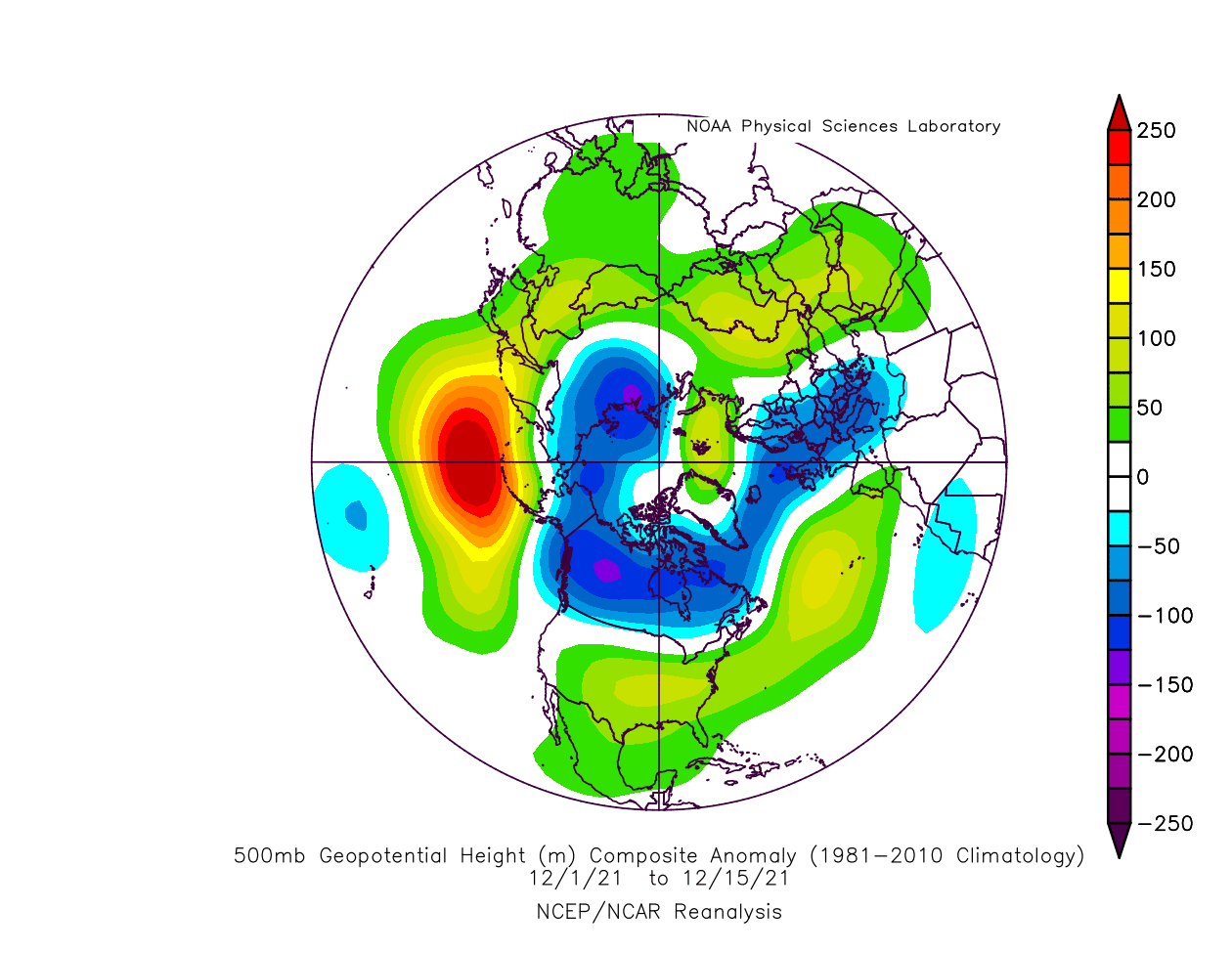
Looking at the global temperatures, we can see most of Europe under colder than normal temperatures. Especially noteworthy was the record cold temperature in Scandinavia. Also, very cold temperatures were present in Canada and Alaska. Warmer than normal temperatures prevailed over most of the continental United States, with a lot of warm records being broken in the past week.
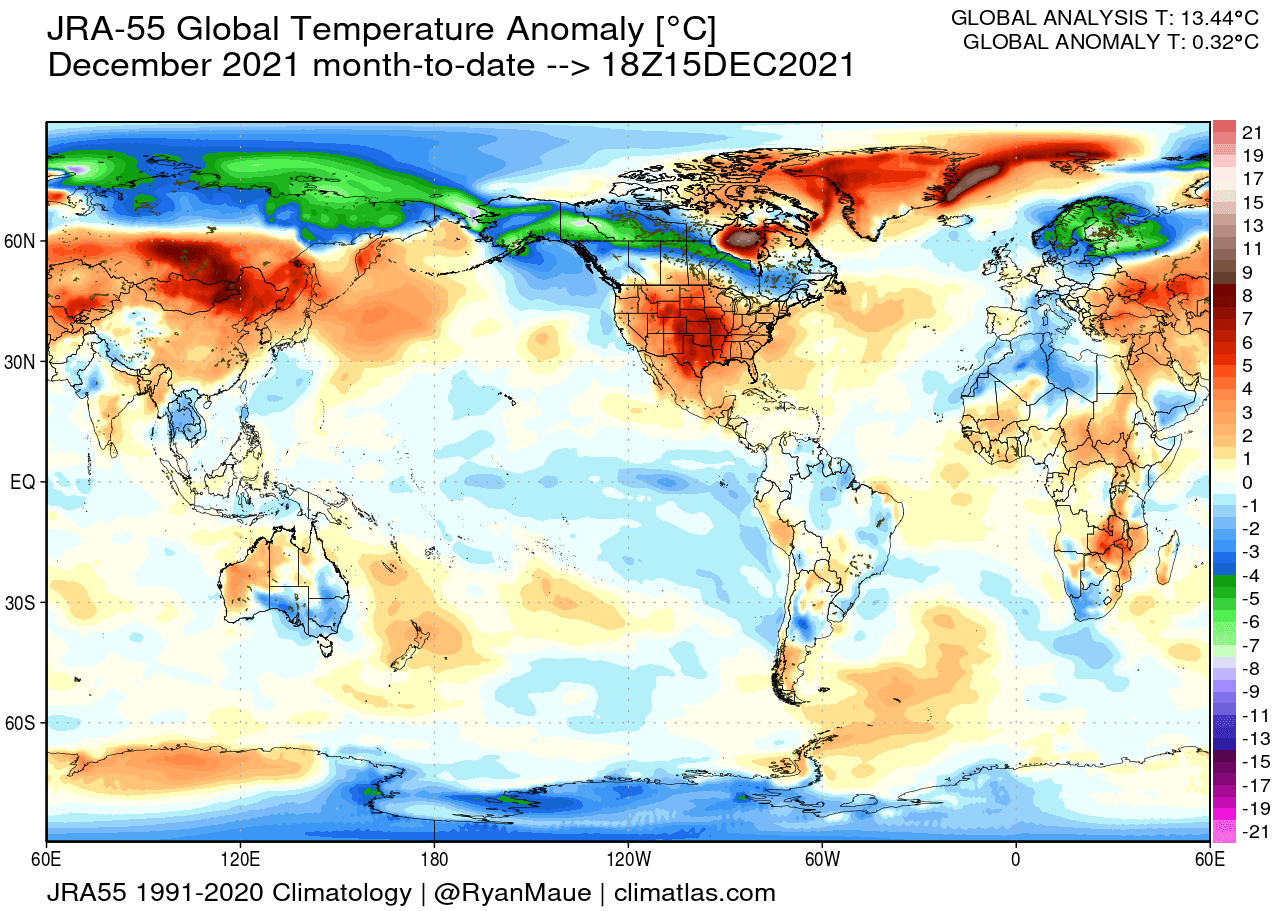
Looking at the latest forecast for mid-month, we can notice a change in the pressure pattern. A high-pressure system is starting to rise again in the North Pacific, into the Aleutians. We also have higher pressure rising from Europe into the North Atlantic. A special pattern is over the United States, with a low-pressure system entering from the west, creating strong southerly flow over the central part of the United States.

This is a unique pattern setting up, called a negative North Atlantic Oscillation. This is a weather oscillation that describes the atmospheric pressure difference between the Iceland/Greenland area and the central North Atlantic.
In a negative NAO, we usually have a blocking ridge in the North Atlantic and into Greenland. Low-pressure systems travel around it, creating an active cold air transport from the polar regions. A strong negative NAO is what every winter lover wants to see in the central and eastern United States and in Europe. The graphic below is by daculaweather.
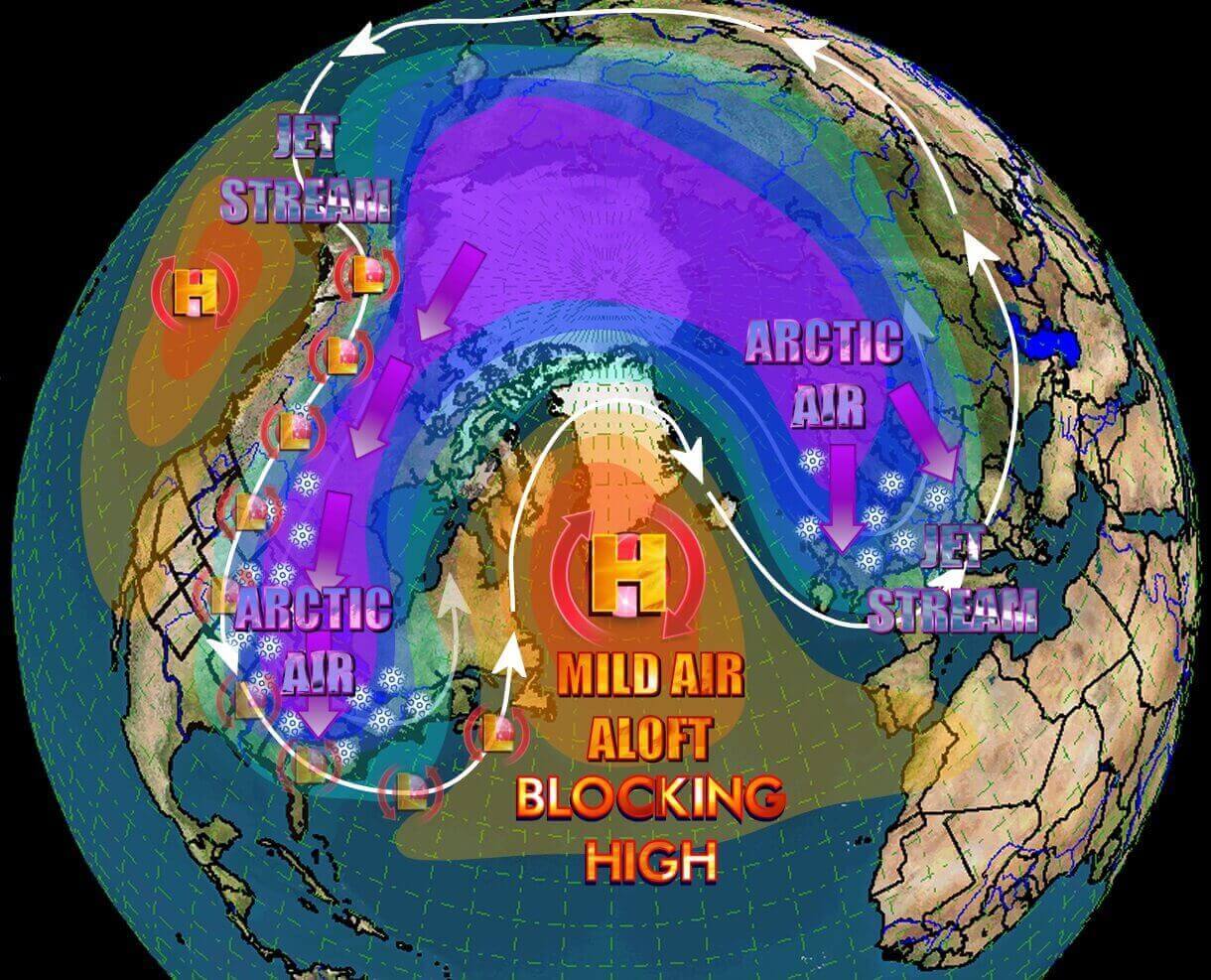
But in the current case, the positioning and the strength of the blocking high-pressure system in the North Atlantic is not that perfect. By definition, it is a negative phase, but the interaction with the strong North Pacific ridge upstream makes it complicated.
In a pure negative NAO pattern, which you can see on the image above, both Europe and the United States can have good winter weather at the same time.
Looking at the mid-month forecast for Europe, we can see a much different pattern compared to the first part of the month. Warmer than normal temperatures will expand over much of western and northern regions, with the expanding high-pressure system also bringing mostly drier weather. Cold is kept to the eastern regions.

Over North America, we can see a strong weather contrast. Much colder than normal temperatures over western Canada, just reaching into the northern and far northeastern United States. At the same time, unseasonably warm weather is expanding over the central and eastern parts of the United States.

Going further into the mid-month, we are going to witness a strong amplification of the pressure pattern. As you can see below, two strong blocking systems will be present over the North Pacific and northwest Europe and the North Atlantic. This is now an even better case of a negative NAO, but the Atlantic high is positioned more to the west.
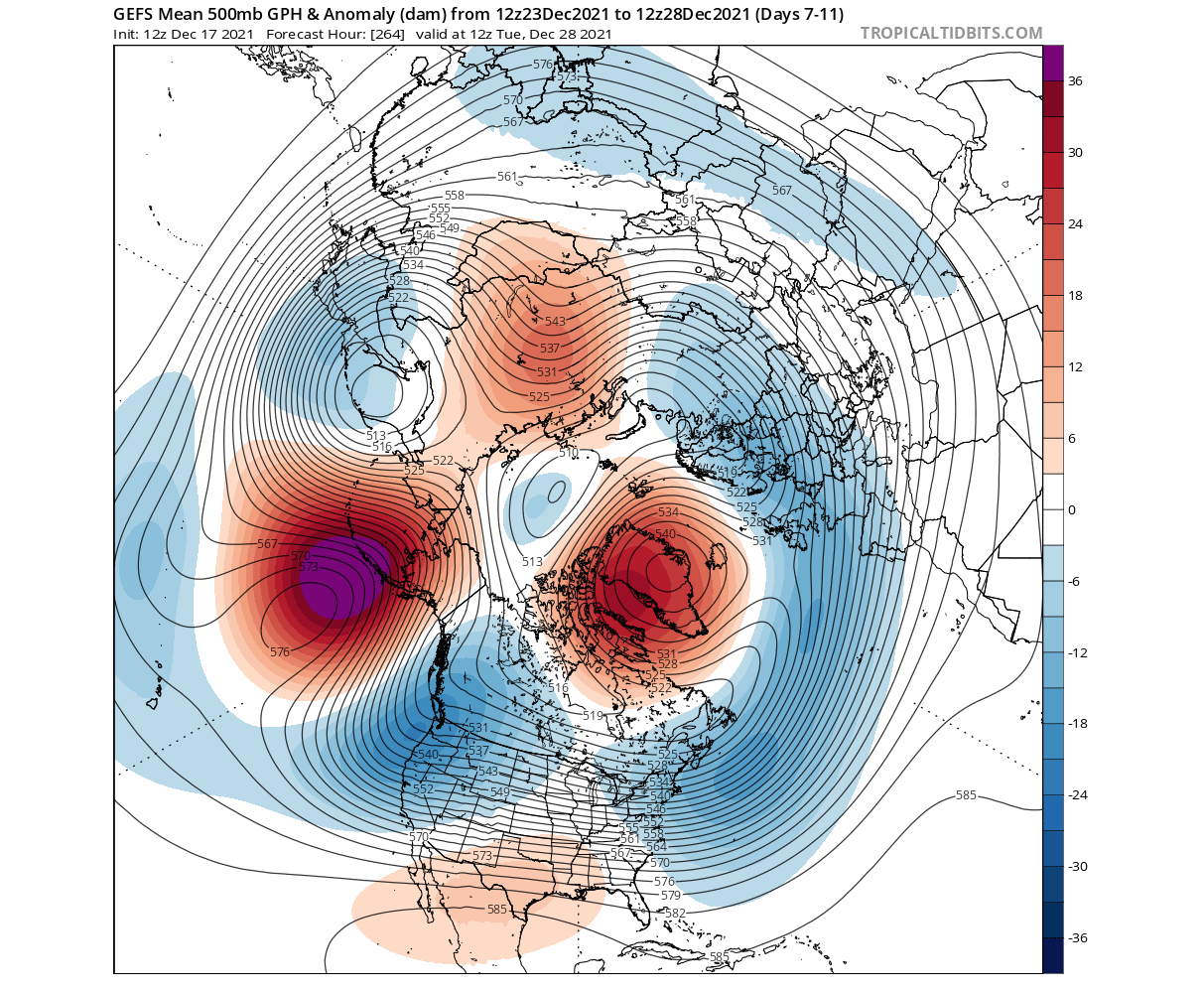
Looking at Europe first, we can see colder air covering most of the northern parts, extending into some north-central countries. Warmer anomalies return to southern and parts of central Europe. That is because the North Atlantic blocking is too far out. That allows the low pressure to undercut it to the point that it starts bringing warmer southerly flow back again.
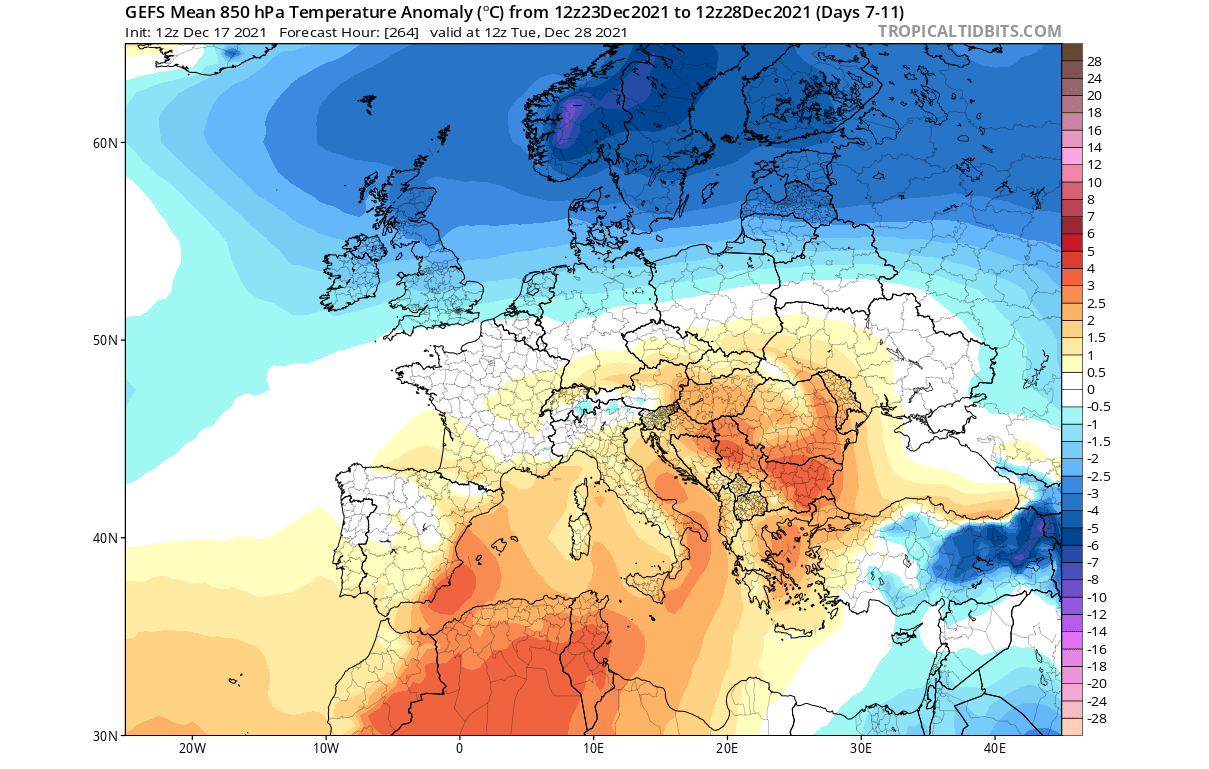
Over North America, we can see that the strong warm anomalies are reappearing in the far southern United States. That is also thanks to the strong high pressure in the North Pacific, which helps to amplify the jet stream over the northern United States and bring a low-pressure system into the western United States. The colder air is expected to cover more of the northern parts of the United States.

Taking a more detailed look, the main deterministic weather model shows an example of how a strong cold air outbreak can quickly spread from western Canada into the northwestern United States and into the Midwest. The far south and the southeastern United States are expected to have quite warmer than normal weather.

END OF THE MONTH WEATHER FORECAST
Going into the end-month period, the pattern persists but evolves. Strong blocking high pressure sits over the Aleutians, a classical La Nina, and the MJO phase 7 feature. The Blocking high also remain over the North Atlantic, but it is quite west-based. We can see a descending low-pressure area into the western United States and lower pressure over Europe.

In Europe, we see a return of the colder pattern into central Europe. This is mostly by the return of a more northerly airflow. This is a situation we have described way back in our long-range winter forecast.

Over North America, we can see a strong cold pool developed over western Canada, extending down into the northwestern United States and the Midwest, also extending into the northeast. Despite seeing warmer temperatures in the southern half of the country, a strong cold air outbreak can be launched from the northwest into the central and eastern regions.
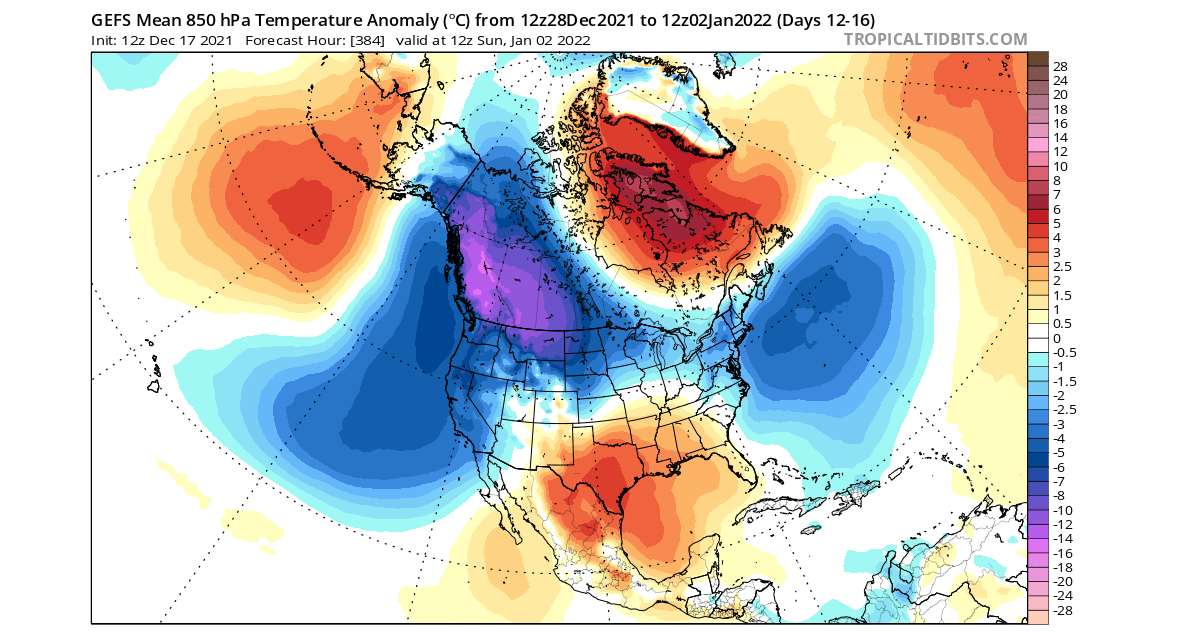
NOAA also regularly releases their 8-14 day forecast for the United States. Below we have the temperature forecast for the post-Christmas period. NOAA calls for colder weather in the west and the northwestern United States, extending into parts of the Midwest and northeast.

Warmer than normal weather is expected in the southern states, especially along the Gulf coast. As we have seen on the latest forecasts above, this can still produce cold outbreaks very quickly into the central part of the United States.
We have the precipitation forecast below, which calls for more precipitation in the west and in the north. The central and southeastern United States can expect drier than normal conditions later in the month.

But this period covers the post-Christmas days. Every year, people are wondering if they will experience a white Christmas in their area. We will look at some trends for the Christmas period, along with some long-term historical probability. You can expect more a detailed look into white Christmas 2021 probability in our upcoming specialized articles.
EARLY JANUARY 2022 WEATHER
Using the ECMWF ensemble forecast, we can take a look deeper into early January. This is the ECMWF extended ensemble prediction system, which is run twice per week.
Looking at the pressure pattern, we see the continuation of the negative NAO pattern, with a blocking high over the North Atlantic. Lower pressure is set to remain under the high-pressure systems, mainly focused on Canada and Europe.
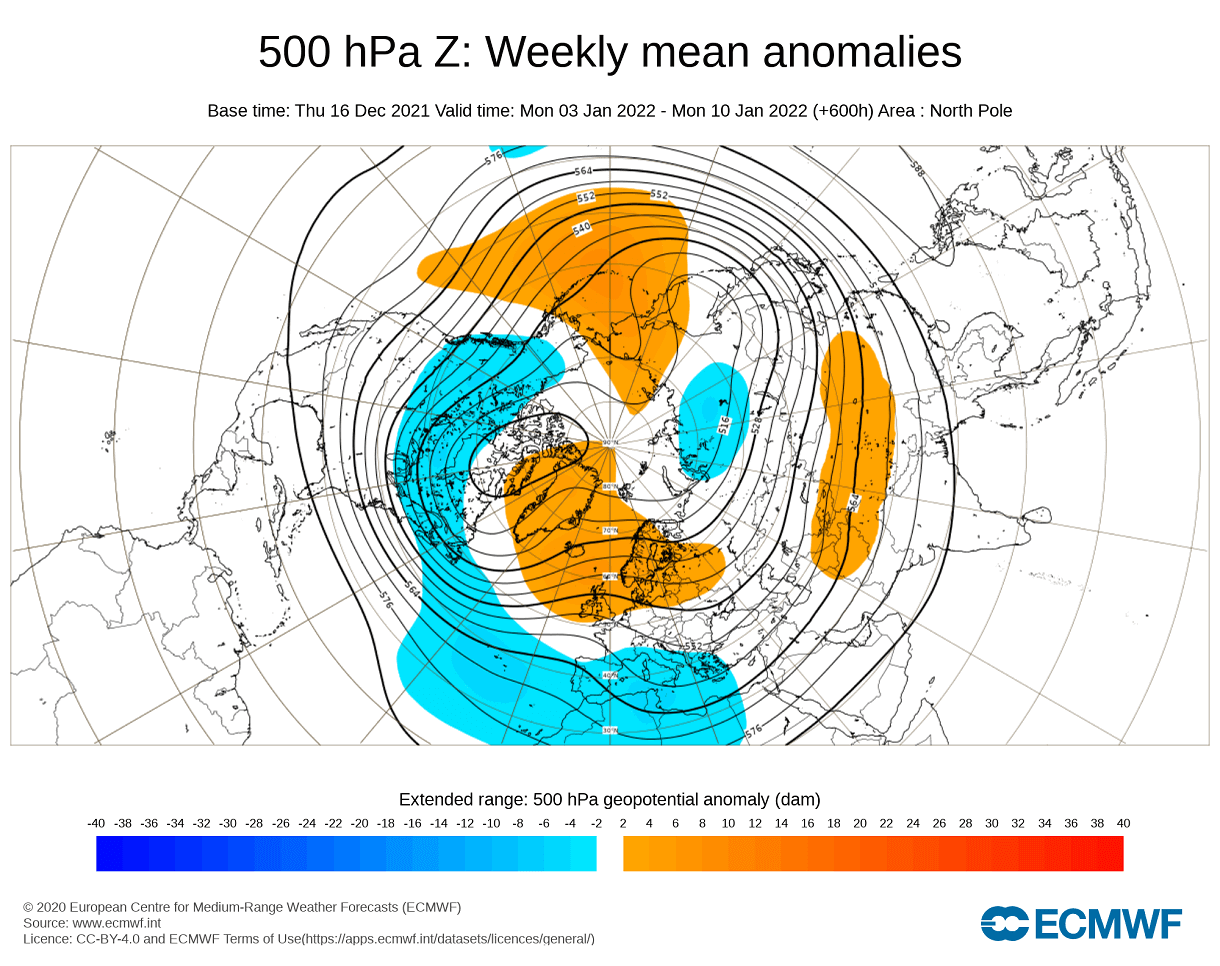
The temperature forecast for Europe suggests colder temperatures in the northeastern and central regions. Based on the pressure pattern, this can be instigated with a northerly to northeasterly airflow.
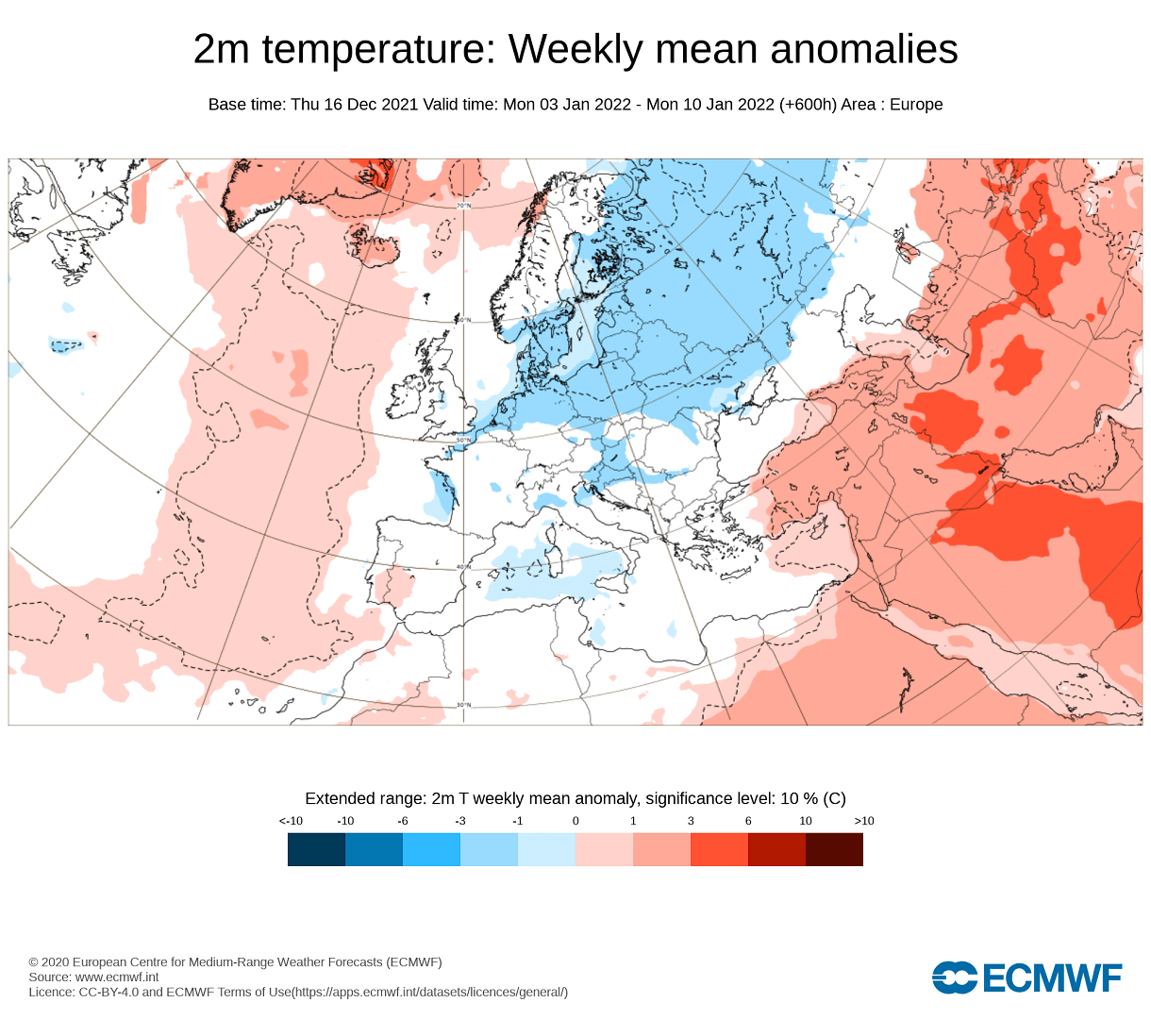
Over North America, the pattern continues from December, with colder air dominating the northwest and the northern United States. Southern states are seen warmer than normal. That is most likely for the gulf coast states, especially Texas. The greatest snowfall potential remains in the northwestern United States over the Midwest and into the northeast.
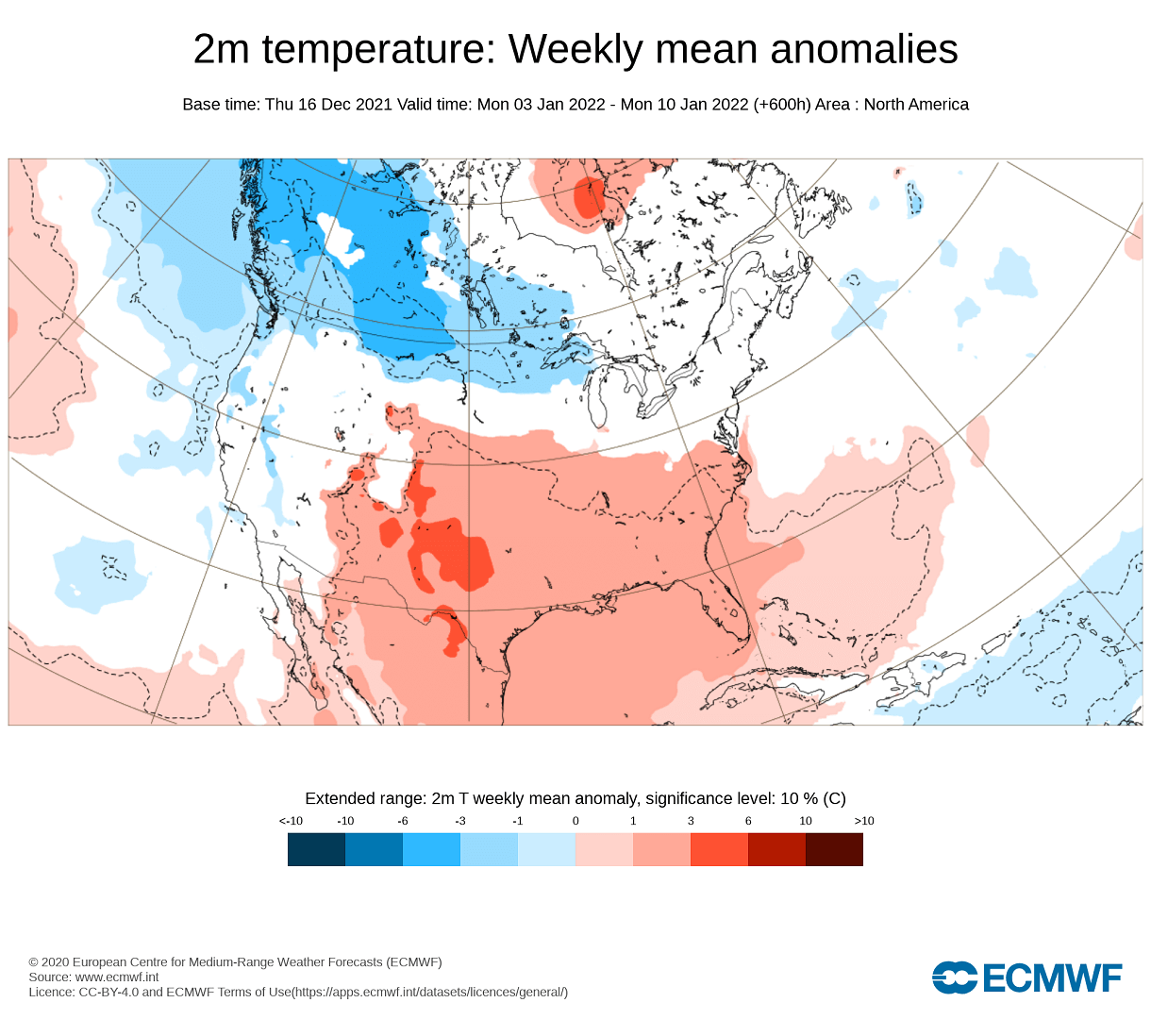
On the way to the new year, we first have to go through the Christmas holidays. Before going deeper into the 2022 weather, we will look at some latest snow trends for Christmas.
WHITE CHRISTMAS PRELIMINARY FORECAST
Before looking at the trends, we need something to compare them to. Usually, the best comparison can be the historical probability for a white Christmas, as we can see the most common areas that get snow on the ground during the holidays in the past.
Starting in Europe, we have a map by the Reddit user Haayoaie. We can see the highest probability in northern Europe, followed by the higher altitudes of central Europe and the Balkans. This is of course strongly connected to colder air, which is found in northern Europe and easily available at higher altitudes.

Over the United States, the story is quite the same. The biggest probability for a white Christmas is over the Rocky Mountains, the Midwest, and the northeastern United States. Probability quickly diminishes as we head towards the south. This is especially the case in La Nina winters, where the southern and southeastern United States tends to be warmer than normal during most of the winter season.
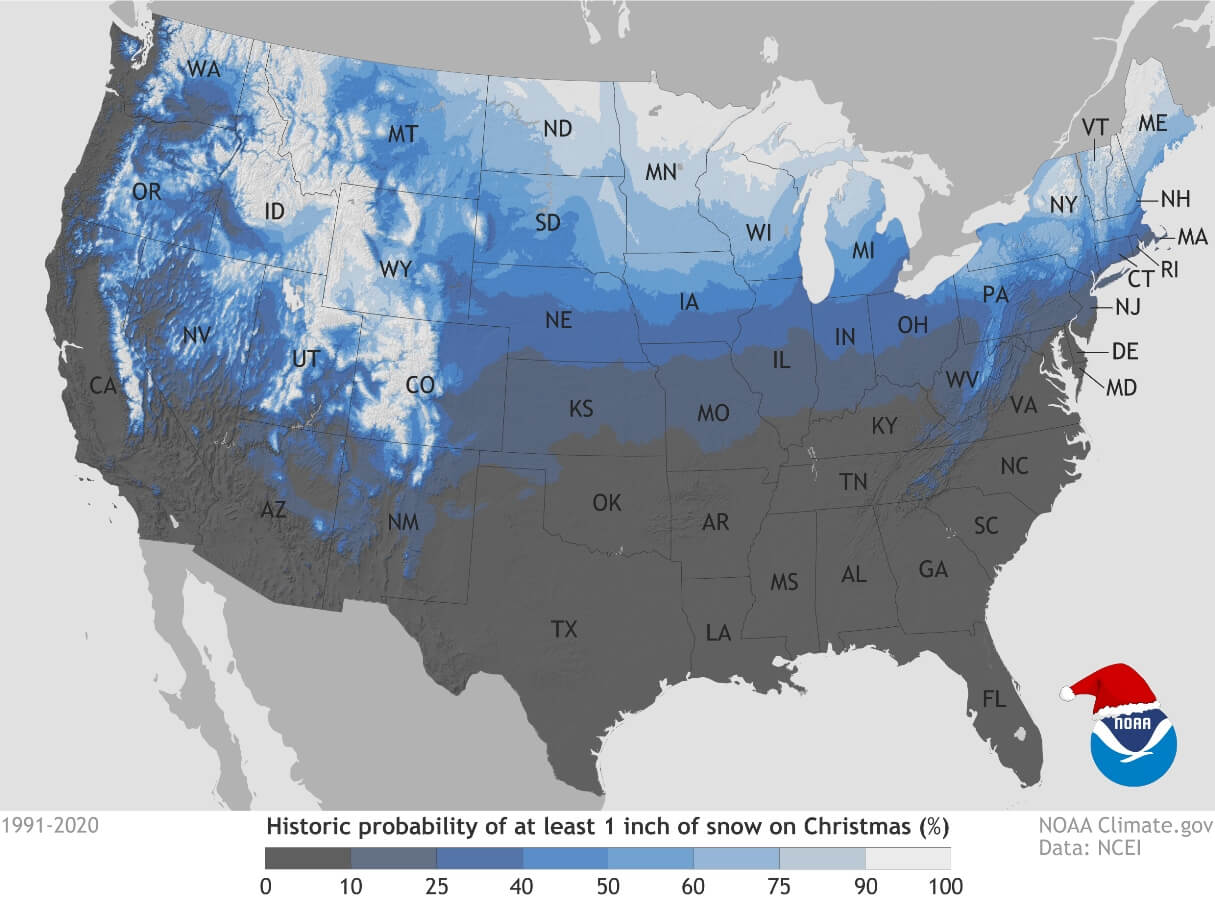
Looking at the actual early snow depth forecast for Christmas, we can see a similar picture as in the historical probability. Northern Europe and the higher altitudes in central and southeastern Europe tend to get more snow on the ground for the Christmas holidays. Most lowlands in central Europe and western Europe have a very low probability of snow on the ground for Christmas.

Over North America, the story is no different. Canada is of course entirely covered with snow. But in the United States, we see snow cover in the Rockies and the northwest. The snow cover is likely to extend across the Midwest into the northeastern United States. central and southern parts of the United States are not expected to have much (or any) snow on the ground for Christmas, typically for a La Nina winter.
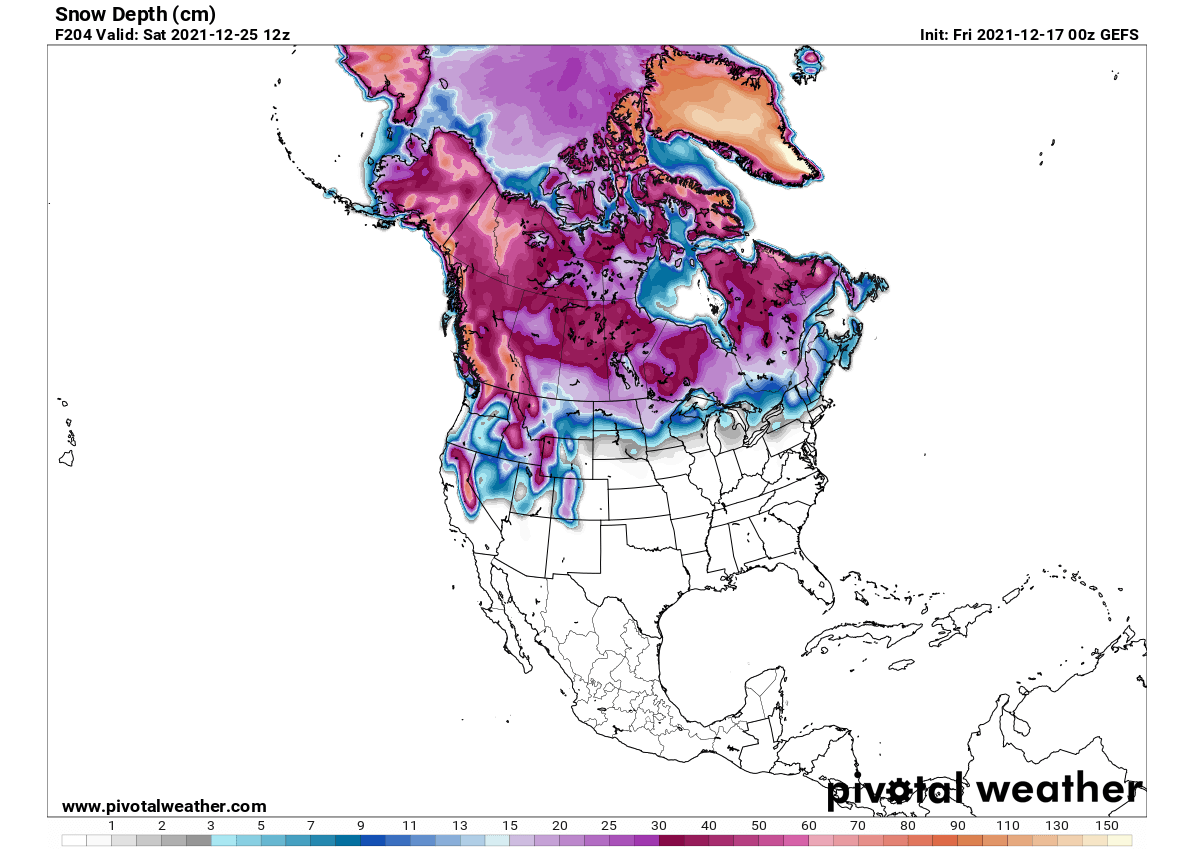
EARLY 2022 WINTER WEATHER PATTERN
We will quickly extend our look into the seasonal trends for early 2022, using the ECMWF forecast. The period in question is the January-February-March season, so the first Spring month is included in the forecast. But since the winter months have typically more powerful patterns, the signal from March typically has a weaker contribution to the average.
The forecast contains the latest data and was issued earlier this month. As we can see below on the pressure pattern forecast, the strong high-pressure system in the North Pacific is still present. That is the signature of the La Nina and is likely to stay present well into the early Spring season. Notice the much lower pressure over most of Canada, curving the jet stream into the northwestern United States.
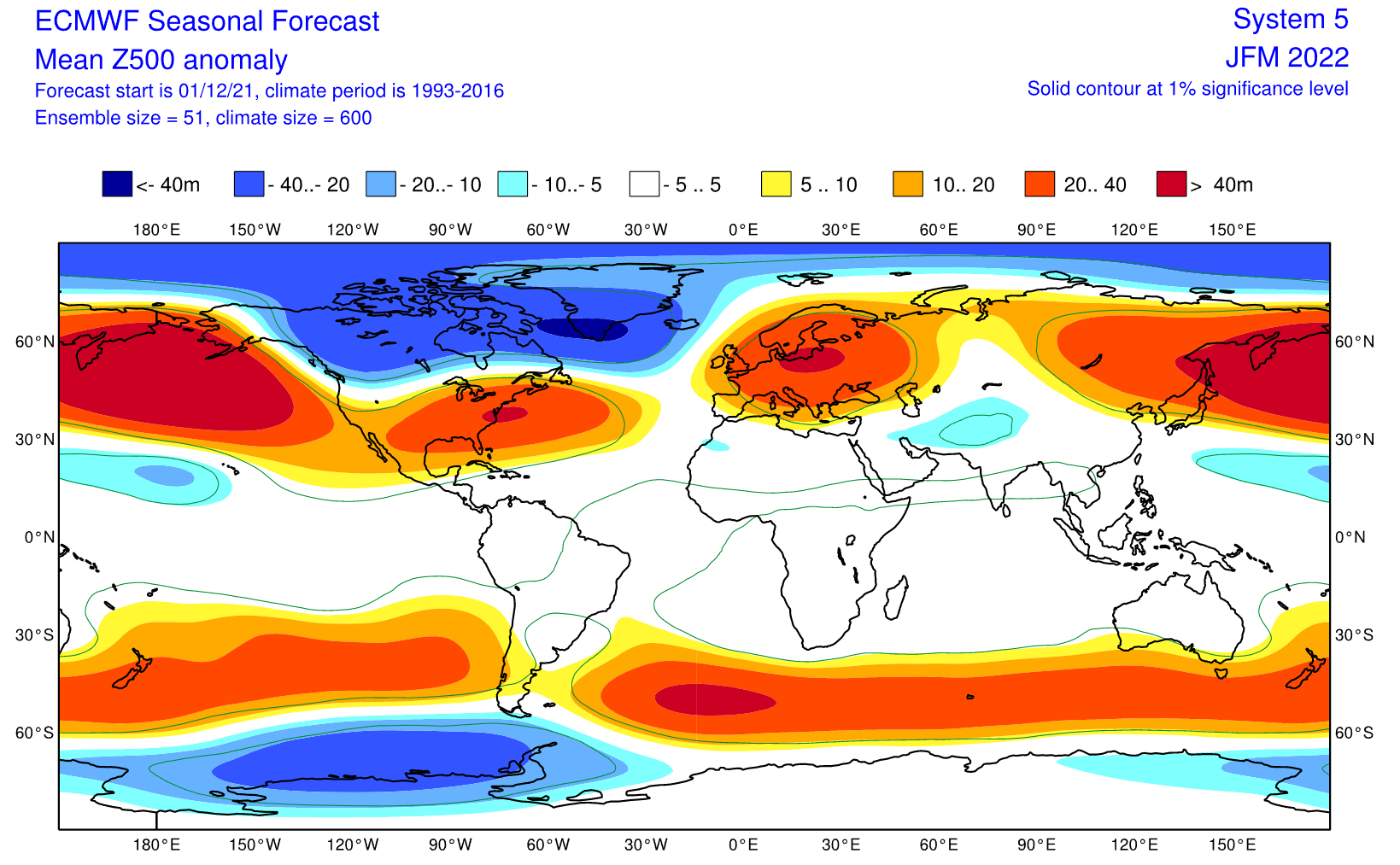
Looking at the global airmass temperatures, we see the strong cold pool in western Canada. That is forming this month and is set to stay till the end of the winter season. Notice the warmer temperatures over much of Europe, which would suggest a pattern change to a more westerly flow, following the colder than normal December.
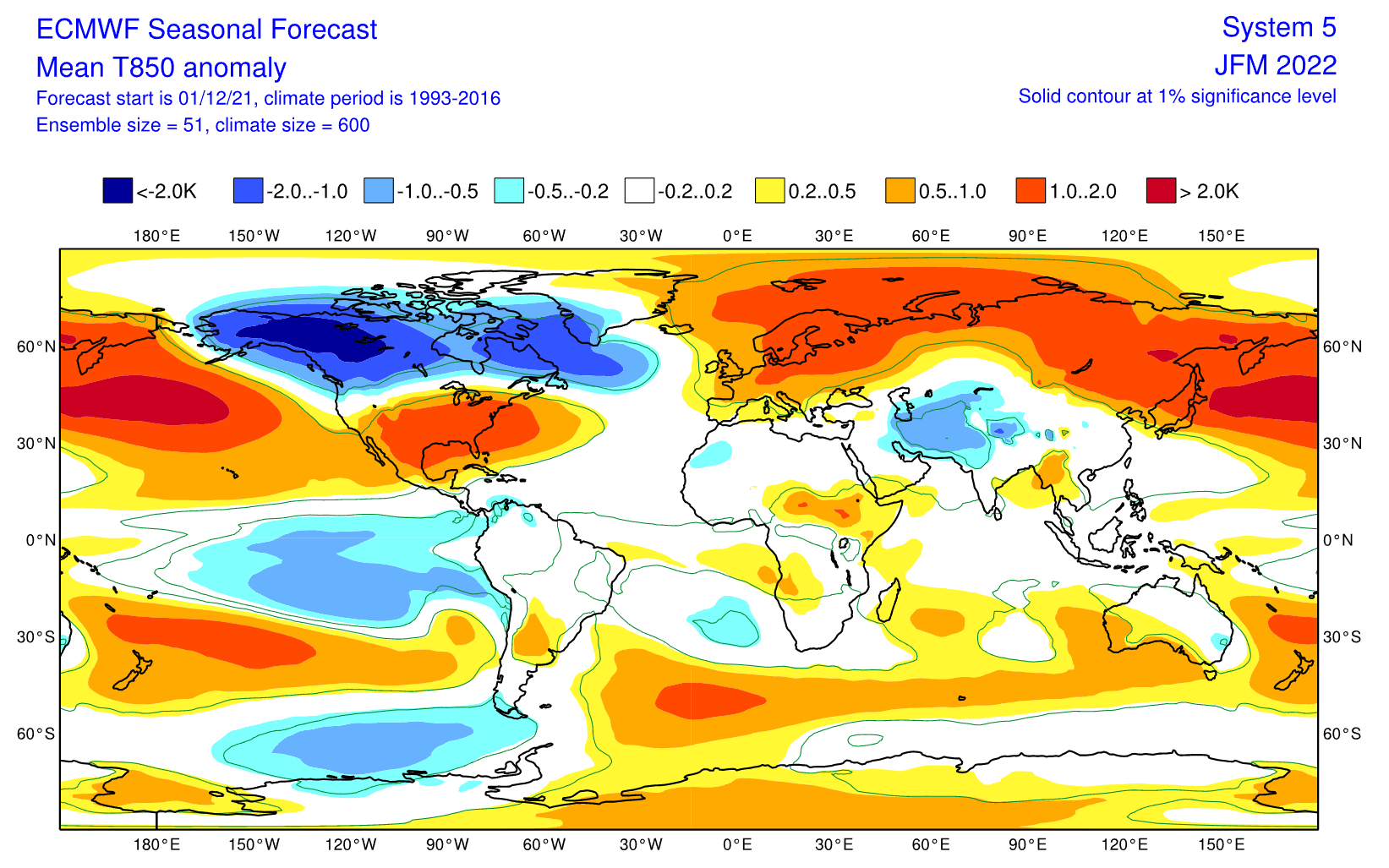
Looking closer at Europe we see the surface temperatures to be mostly above normal in northern Europe. There is however a neutral zone in parts of central Europe, suggesting that colder air intrusions can continue in January and February. That is similar to what we are seeing now in December, but with a lesser frequency. These forecasts only show the prevailing or average picture over the course of 3 months, which can contain a lot of variances.

Over North America, we see the large cold pool over western Canada and Alaska. That comes from the north flow due to the blocking high over the North Pacific. In this pattern, cold air can quickly spread into the midwest and the central United States, as we have seen this month already, despite warmer than normal conditions being forecast in the average.

Looking quickly at the global precipitation forecast, we see mostly drier than normal conditions over Europe, under higher pressure. Over North America, more precipitation is forecast over Canada, which is mostly snowfall. More precipitation is also forecast over northwestern and northeastern parts of the United States. The southern United States is forecast to be normal to drier than normal, typical for a La Nina.

Below we have the official temperature forecast for the United States by NOAA, for the Jan-Feb-Mar 2022 season. It shows the temperature probability, with colder to equal chances in the northern United States. The southern half of the country and the northeast have a higher probability of warmer than normal weather, which we saw in the long-range forecast above.

Such a pattern however still allows for strong cold air outbreaks into the Midwest and the northeast. A strong cold pool will be present in western Canada, which can be triggered to send a cold air outbreak into the United States as soon as the pressure pattern swing occurs.
The official precipitation forecast also supports the models above. We see an equal-to-higher probability for more precipitation (and snowfall) in the northwestern and the northeastern United States. The Southern United States is forecast to have a drier than normal start of 2022, thanks to the active cold ENSO phase.

We will release regular weekly and monthly updates during the winter season as fresh forecasts and data are available. So make sure to bookmark our page. Also, if you have seen this article in the Google App (Discover) feed, click the like button (♥) there to see more of our forecasts and our latest articles on weather and nature in general.
SEE ALSO:
A Massive Cold Outbreak Heads for Europe This Week, but what about Snow and White Christmas Forecast?